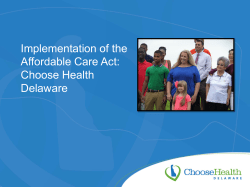
The Affordable Care Act: A Policy and Implementation Update 5/27/2014
5/27/2014 The Affordable Care Act and Breast Health Coverage Sara Eskrich, Project Assistant – Health Policy, UW Population Health Institute The Affordable Care Act: A Policy and Implementation Update Breast Cancer Conference for Community Health Workers May 30, 2014 Where do Wisconsin Women Get Health Insurance? What is the ACA? • Stands for “Affordable Care Act” -- otherwise known as the health care law or “Obamacare” • Health insurance reform • Became law on March 23, 2010 • Different parts affect different groups of people, two main stages – Stage 1 focuses on patient protections (now) – Stage 2 focuses on expanding coverage (2014) Women 19-64, 2010-11 US Census Bureau Decline in Employer-sponsored Insurance (CPS data for non-elderly population: 2000 to 2011) Uninsured Non-Elderly Wisconsinites 518,246 uninsured, or 10.8% of Wisconsinites 1 5/27/2014 Finances of ACA • Builds on existing private insurance system and seeks to outlaw abuses, fill gaps • Aims to rein in health care costs; reduces deficit by over $100 billion by 2020; by $1.3 trillion by 2030 (according to Congressional Budget Office). • Congressional Budget Office is the nonpartisan “scorekeeper” on budget issues for Congress. Preexisting Conditions in Wisconsin • Nearly 1 million in Wisconsin under age 65 have a preexisting condition that would deny coverage to them if they bought insurance on their own • An additional 1.5 million non-elderly Wisconsinites have preexisting conditions that would cause them to be denied coverage or charged excessive rates. Stage 1 • Outlaws insurance denials based on preexisting conditions for kids (applies to adults in 2014) • Added $5B to state “preexisting pools” to allow more participants and reduce premiums until 2014 when it will be illegal to discriminate against adults with preexisting conditions. Stage 1 • Allows young adults to stay on parents’ policies until they are 26 • Eliminates lifetime limits • Phases out annual limits (gone in 2014) • Can’t drop coverage after a person gets sick or for an honest mistake on your insurance application Source: U.S. Department of Health & Human Services, January 2011 Stage 1 Stage 1 • Insurance must spend at least 80% of your premiums on medical care • Double digit premium increases must be publicly reviewed, are subject to approval • Small business tax credits: Up to 35% back if providing employees health insurance ($40 billion in credits by 2019) Additions to Medicare: • Preventive services such as checkups and screenings with no Part B co-pay or deductible. • 50% discount on brand-name drugs when you hit the “donut hole” coverage gap. • Solvency of Medicare extended through efficiencies, fighting waste, prevention, ending subsidies to insurance companies 2 5/27/2014 Stage 1 • Many preventive care services must now also be offered by private insurance without co-pay or deductible. • Over 1.1 million Wisconsinites already benefiting. • Includes things such as: – Mammograms, blood pressure screenings, many cancer screenings, immunizations, diet & losing weight, quitting smoking, etc. – Full list at www.healthcare.gov Why Prevention? • Chronic diseases are responsible for 7 in 10 American deaths and account for 75% of U.S. health spending. • BUT chronic diseases are often preventable. • Often because of cost, Americans use preventive services at about half the recommended rate. Source: U.S. Department of Health and Human Services. Women’s Preventive Services As of August 1st 2012, all new insurance plans and those renewing without “grandfathered” status, are required to provide (with no cost-sharing*) the following services: •the full range of FDA-approved contraception methods and contraceptive counseling •well-woman visits •screening for gestational diabetes •human papillomavirus (HPV) DNA testing for women > 30 years •sexually-transmitted infection counseling •human immunodeficiency virus (HIV) screening and counseling; •breastfeeding support, supplies, and counseling •domestic violence screening and counseling Nearly one million women in WI are expected to benefit. *No copayments, deductibles or co-insurance. Problems? Breast Cancer Screening and the ACA • The ACA mandates coverage of mammography for breast cancer screenings: USPSTF recommendation of every 1-2 years for women 40+. • Wisconsin law mandated 2 exams for 45-49 and one per year for 50+. • As part of the ACA, Medicare covers the full cost of one mammogram per year for women 40+. • Counseling and testing for BRCA 1 and BRCA 2 genes for women who have a family history of breast and ovarian cancer. • Breast Cancer Chemoprevention counseling for women at higher risk. 1-866-PILL-4-US or pill4us@nwlc.org Stage 2 The bulk of the health care law went into effect on January 1, 2014 to help expand coverage Stage 2 Individual mandate in concert with: • Preexisting condition exclusions outlawed for everyone, no discriminatory practices, like gender rating • Expansion of Medicaid (BadgerCare) • Creation of competitive health marketplace (exchange) • Addition of individual tax credits to help middle class pay for insurance in exchange • Increase small business tax credit to up to 50%. 3 5/27/2014 The Individual Mandate Individual Mandate Exemptions Some individuals may be exempt including: • Most individuals will be required to have insurance or pay a tax penalty/fee • 2014: $95 per adult or 1% of income • 2016: $695 per adult or 2.5% of income • Penalty also referred to as the “Shared Responsibility Payment” • Individuals may be uninsured for a period of up to three months before penalty would apply • • • • Religious conscience; Membership in a health care sharing ministry; Member of an Indian tribe; Taxable income below the threshold to pay taxes ($9,750 for individual in 2013 tax year) • Hardship (based on personal circumstance or a lack of affordable coverage); and • Ineligible for Medicaid based on a state’s decision not to expand (In WI, incomes between $11,490-15,282 for individual). ACA and Employer Coverage • Employees with coverage through their job: o Most will experience no changes unless the employer decides to make changes ACA and Employer Coverage • Employees without coverage through their job: o If you work for a large employer (over 100 employees), they must offer insurance beginning in January 2015 or pay a fine (Applies to employers with 50-99 employees in 2016) o If you work for a small employer (less than 50 employees) the employer is not required to offer insurance, but can choose to through the SHOP 4 5/27/2014 BadgerCare+ Groups, 2014 BadgerCare+ and ACA • Under the ACA, states were to expand their Medicaid programs, the Supreme Court effectively made that a state option • Wisconsin’s administration decided to modify BadgerCare+ eligibility guidelines: expanding coverage for some and eliminating coverage for others Premiums Start at 200% Premiums Start at 200% No Premiums No Premiums • Changes are pending federal CMS approval Updated October 11, 2013 Premiums Start at 200% Premiums Start at 200% No Premiums No Premiums The Marketplace/Exchange Who can Buy in the Marketplace? People can access coverage in the Marketplace, if: • Are currently uninsured • Are not incarcerated • Do not have access to affordable insurance through their employer • Have affordable employer-sponsored coverage, but would like to explore their options (Note: not eligible for tax credits) Updated October 10, 2013 5 5/27/2014 Insurance Plans in the Marketplace • Insurance plans available through the Marketplace must be qualified and cover 10 essential health benefits • Plans are categorized as Platinum, Gold, Silver, or Bronze • • Pay monthly premium for coverage Essential Health Benefits • • Minimum benefits for non-group and small group plans in and out of exchanges (also some Medicaid and BHP) 10 Categories in the ACA: i. ii. iii. iv. v. vi. vii. viii. ix. x. • • Ambulatory patient services Emergency services Hospitalization Maternity and newborn care Mental health and substance use disorder services, including behavioral health treatment Prescription drugs Rehabilitative and habilitative services and devices Laboratory services Preventive and wellness services and chronic disease management Pediatric Services, including oral and vision care States decide benchmark plan, largest small group plan is default, UnitedHealthcare Choice Plus – will be default in 2014 and 2015 2016 presents an opportunity to reassess approach Bronze – 60%, Silver – 70%, Gold – 80%, and Platinum – 90%, catastrophic (high deductible plan) All plans cover preventive services without out-ofpocket costs • People can choose which plan works for them based on value, cost, and a standard summary of benefits and coverage WI Insurers in the Marketplace Available plans vary by County Common Ground Healthcare Cooperative Compcare Health Services Insurance Corporation Dean Health Plan, Inc. Group Health Cooperative of South Central Wisconsin Gundersen Health Plan, Inc. Health Tradition Health Plan Medica Health Plans of Wisconsin MercyCare HMO, Inc. Molina Healthcare of Wisconsin, Inc. Physicians Plus Insurance Corporation Security Health Plan of Wisconsin, Inc. Unity Health Plans Insurance Corp. Arise (WPS Health Plan, Inc.) – Important to be part of that conversation. What is the cost of coverage? • Cost is influenced by: tobacco use geographic location age • Costs will vary based on the plan and tier of coverage chosen • The most an individual will pay is between 2-9.5% of their income • Go to the Kaiser Family Foundation Premium calculator for a cost estimate: http://kff.org/interactive/subsidy-calculator/ 6 5/27/2014 Is there financial assistance available? • Congressional Budget Office estimates that 7/8 will qualify for a subsidy (discount) • Subsidies are available for those between 100-400% FPL $11,490-$45,960 for an individual $23,550-$94,200 for a family of four • Cost-sharing assistance is available for individuals with income between 100-250% FPL (must purchase silver level plan!) $28,725 for an individual $58,875 for a family of four • Maximum out-of-pocket limit in 2014 of $6,350 for an individual and $12,700 for a family (applies to all insurance plans) Updated October 11, 2013 Amount of financial assistance • Assessment of eligibility for and amount of premium tax credit is made through the Marketplace • Amount of subsidy = cost of second lowest cost silver plan in the individual’s geographic area – amount the individual is expected to pay (sliding scale of 2%-9.5% of family income) • Full amount of tax credit can be used to purchase any plan sold on the Marketplace • So, if you buy a bronze level plan, the PTC will cover more of the premium, if you buy a platinum level plan, the PTC will cover less of the premium cost Updated October 11, 2013 Receiving financial assistance Cost-Sharing Reductions • Cost-sharing reductions are automatically included for individuals with income between 100-250% FPL who are receiving premium tax credits and purchase a silver level plan • When shopping for coverage, eligible individuals will see the cost-sharing reductions reflected in prices • Their purchased plan will have a lower deductible, out-ofpocket maximum, or copayments Eligibility for financial assistance • Must not have access to “minimum essential coverage”: • Medicare • Medicaid • An offer of Employer-Sponsored Coverage that is “adequate” and “affordable” • What does “adequate and affordable” ESI mean? • Adequate – minimum value of at least 60% • Affordable – employee-only coverage costs less than 9.5% of household income • Ex) employee + dependent coverage offered and costs less than 9.5% of household income – employee and kids are not eligible for PTCs, however spouse is eligible for PTCs Updated October 11, 2013 Receiving financial assistance • Premium tax credits are refundable, so individuals with little or no income can still benefit (like the EITC) • However, must file taxes in year PTC are received • Premium tax credits can be paid “in advance,” directly to the insurance company • Advanced Premium Tax Credits allow individuals to only pay their portion of the premium to the insurer • Don’t have to take PTCs in advance, or take full amount • APTCs are subject to reconciliation upon tax filing • Reporting changes in income throughout the year is critical Updated October 11, 2013 Enrollment Periods • October 1, 2013- March 31, 2014 (April 15): Open Enrollment: Individuals can sign up for health insurance plans on the Marketplace • Special Enrollment Periods: qualifying life events such as losing other insurance coverage, moving out of a plans service area or gaining new dependents may qualify someone for a special enrollment period • Unlike PTCs, cost-sharing reductions are not administered like a tax credit, and do not need to be reconciled at tax time, however, income changes should be reported to recalculate the PTC and cost-sharing reductions throughout the year Updated October 11, 2013 Updated October 11, 2013 7 5/27/2014 Enrollment Assistance Four Key Messages to Reach Most Uninsured • In person: Navigators and Certified Application Counselor organizations Agents and brokers Inventory available - www.e4healthwi.org • By phone: All insurance plans will have to cover doctor visits, hospitalizations, maternity care, emergency room care, and prescriptions. You might be able to get financial help to pay for a health insurance plan. If you have a pre-existing condition, insurance plans cannot deny you coverage. All insurance plans will have to show the costs and what is covered in simple language with no fine print. One of these = top message for 89% of population through a national call center 1-800-318-2596, Call 211 for local supports • Online: chat with a Marketplace representative when filling out an application at www.healthcare.gov Updated October 11, 2013 Source: Enroll America, November 2012 Wisconsin Marketplace Enrollment, by Plans Selected, 2014 Open Enrollment: October 1, 2013 – April 19, 2014 Update: Wisconsin Marketplace and BadgerCare+ Enrollment 46 HHS Enrollment Report, May 2014, http://aspe.hhs.gov Wisconsin BadgerCare+ Enrollment Changes for Adults, Implemented April 1, 2014 Wisconsin Marketplace Enrollment, by Plans Selected, October 1, 2013 – April 19, 2014 April 1, 2014 BadgerCare+ Changes 100,000 • Total enrollment in BadgerCare+ grew by about 34,000 in April, after significant declines in the previous year. • Awaiting more data on transitioning adults to Marketplace coverage. 80,000 60,000 40,000 20,000 0 -20,000 -40,000 -60,000 -80,000 Series1 HHS Enrollment Report, May 2014, http://aspe.hhs.gov Newly Eligible Childless Adults Removed Adults from BC+ 81,731 -62,776 47 8 5/27/2014 www.ckfwi.org Training, fact sheets, blog, Wisconsin-specific resources, list serve http://www.ckfwi.org/affordablecareacthome.html RESOURCES February 13, 2014 www.e4healthwi.org Local resources and training information, assistance request www.dhs.wisconsin/health-care Webcast, PowerPoint training, FAQs and information on Regional Enrollment Networks Updated October 10, 2013 Updated October 10, 2013 Questions/Follow-Up Spread the Word About Health Care Reform! » Tell someone you know about what women and our families are getting from the ACA. » Advocate on the state budget! Tell legislators to cover more people for less money. » Host an educational session in your neighborhood, your church or community center. » Share your story! Have you already benefited from health care reform? Visit raisingwiwomensvoices.org to tell us how! For more information visit raisingwiwomensvoices.org or subscribe to our health reform blog at rwwv.wordpress.com. Sara Eskrich MPH Candidate, UW School of Medicine and Public Health Project Assistant, UW Population Health Institute, Covering Kids & Families eskrich@wisc.edu Wisconsin Women: Get Covered! WCCF: Frequently Asked Questions Kaiser Family Foundation 9
© Copyright 2025





















